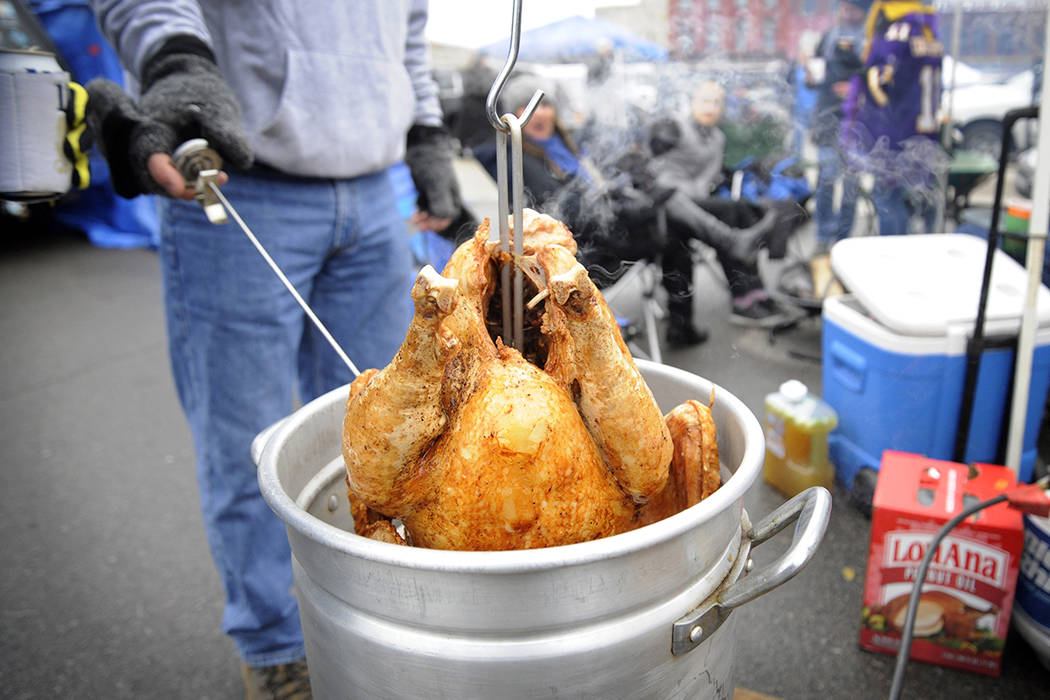Las Vegas Fire Department offers Thanksgiving safety tips
While families across the valley are planning their Thanksgiving feasts, the Las Vegas Fire Department wants to make sure it’s a safe holiday.
According to the U.S. Fire Administration, there are about 2,000 residential fires reported across the country on Thanksgiving each year. The National Fire Protection Association said that Thanksgiving usually sees three times the average number of cooking fires.
But these fires can be easily prevented, the Fire Department said. In 2016 through 2018, the department said there were no cooking-related fires in Las Vegas on Thanksgiving. In an effort to ensure another flame-free year, they offered the following safety tips:
If you’re deep-frying a turkey
— Only use an approved turkey fryer with four legs and a built-in thermostat, to maintain proper oil temperature. Make sure the fryer can’t tip over.
— Never use a fryer indoors. Fry your turkey outside, away from buildings and anything that might catch fire. Keep children and pets away while frying.
— Follow instructions on what size turkey to use, how it should be cooked and what type of oil to use.
— Make sure the turkey is completely thawed and dry when you put it in the fryer. Do not stuff the bird and don’t forget to take out the bag of gizzards. Lower the turkey into the hot oil slowly.
— Never leave the fryer unattended, and make sure you wear fry gloves. Regular oven mitts might not be enough, as splashing oil can cause serious burns.
— If you’re frying your turkey in an apartment complex, make sure you keep the fryer at least 10 feet from any buildings or walls. The fryer can’t be under an overhang or balcony, and it can’t be used above the first floor or on patios of upper floors.
If you’re cooking in the kitchen
— Don’t leave the kitchen unattended: According to the Fire Department, unattended cooking is by far the leading cause of Thanksgiving fires. If you do need to leave the kitchen, turn off the stove.
— If you are sleepy or have consumed alcohol, don’t use the stovetop.
— If you are using a natural gas or propane stove, make sure you run vents to circulate the carbon monoxide. Open windows and doors in the kitchen at least once an hour to circulate fresh air.
— If something on your stove catches fire, shut off the stove and cover the burning pan with a lid or use a fire extinguisher. Do not throw water, salt, flour or any other substance on the fire, as they can cause the fire to flare. Do not try to move a burning pan outside.
— If something in the oven catches fire, shut the oven off and leave the door shut. Call 911 and report the fire, then leave the home until firefighters arrive.
— If the fire gets too big and you feel you can’t handle it on your own, evacuate the house and call 911.
Other safety tips
— Make sure you check that your smoke alarm and carbon monoxide alarms work before you start cooking.
— If you use candles for decorations, never leave them unattended and keep combustible items at least a foot away. Consider using LED candles instead.
— Never use a barbecue or other outside cooking device inside the home; the fire or smoldering coals will produce deadly carbon monoxide gas that can overcome everyone in the building without warning.
— If you use a fireplace, make sure the damper is open and the chimney flue is clear to allow smoke and gases to escape properly. Only burn one log at a time. Never let the fire go above the lentil. Discard ashes into a pail of water and let them soak for several hours before throwing them away.
— At the end of the night, make sure to do a final check of all appliances in your home, especially the stove. Make sure everything is turned off, and any ashes from fireplaces or barbecues are put in a pail of water.
— Make sure your lights are turned off and candles have been put out.
Contact Alexis Egeland at aegeland@reviewjournal.com or 702-383-0335. Follow @alexis_egeland on Twitter.























